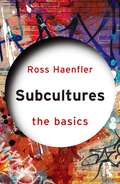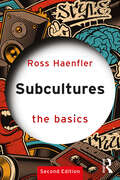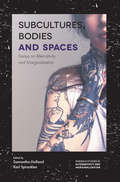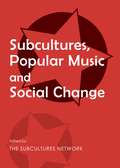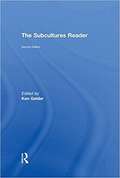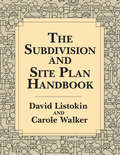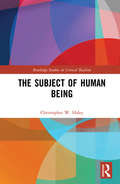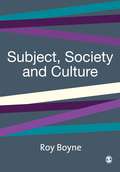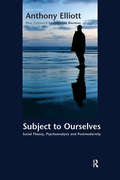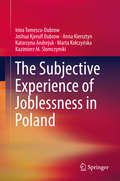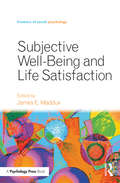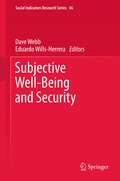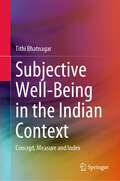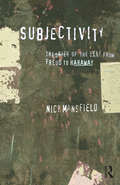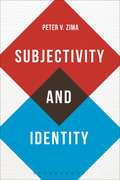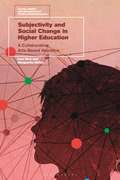- Table View
- List View
Subcultures: Deviance And Youth Subcultures (The Basics)
by Ross HaenflerSubcultures: The Basics is an accessible, engaging introduction to youth cultures in a global context. Blending theory and practice to examine a range of subcultural movements including hip hop in Japan, global graffiti writing crews, heavy metal in Europe and straight edge movements in the USA, this text answers the key questions posed by those new to the subject, including: What is a subculture? How do subcultures emerge, who participates and why? What is the relationship between deviance, resistance and the ‘mainstream’? How does society react to different subcultural movements? How has global media and virtual networking influenced subcultures? Is there a life ‘after’ subculture? Tracing the history and development of subcultures to the present day, with further reading and case studies throughout, this text is essential reading for all those studying youth culture in the contexts of sociology, cultural studies, media studies, anthropology and criminology.
Subcultures: Deviance And Youth Subcultures (The Basics)
by Ross HaenflerSubcultures: The Basics is an accessible and engaging introduction to subcultures in a global context. This fully revised new edition adds new case studies and an additional chapter on the digital lives of subculturists as well as reflections on the relationships between subcultures and globalisation and the resurgence of the far-right. Blending theory and practice, this text examines a varied range of subcultures including hip hop, graffiti writing, heavy metal, punk, gamers, burlesque, parkour, riot grrrl, straight edge, roller derby, steampunk, b-boying/b-girling, body modification, and skateboarding. Subcultures: The Basics answers the key questions posed by those new to the subject, including: What is a subculture? What are the significant theories of subculture? How do subcultures emerge, who participates and why? How do subcultural identities interact with other aspects of self, such as social class, race, gender, and sexual identity? What is the relationship between deviance, resistance and the ‘mainstream’? How have both progressive and reactionary subculturists contributed to social change? How does society react to different subcultures? How have subcultures spread around the world? In what ways do digital technologies and social media influence subcultures? What happens when subculturists age? Tracing the history and development of subcultural theory to the present day, this text is essential reading for all those studying subcultures in the contexts of sociology, cultural studies, history, media studies, anthropology, musicology, and criminology. It pushes the field forward with cutting-edge theories of resistance and social change, place and space, critical race and queer studies, virtual participation, and ageing and participation across the life course. Key terms and concepts are highlighted throughout the text whilst each chapter includes boxed case studies and signposts students to further reading and resources.
Subcultures: The Basics (The Basics)
by Ross HaenflerSubcultures: The Basics is an accessible, engaging introduction to youth cultures in a global context. Blending theory and practice to examine a range of subcultural movements including hip hop in Japan, global graffiti writing crews, heavy metal in Europe and straight edge movements in the USA, this text answers the key questions posed by those new to the subject, including: What is a subculture? How do subcultures emerge, who participates and why? What is the relationship between deviance, resistance and the ‘mainstream’? How does society react to different subcultural movements? How has global media and virtual networking influenced subcultures? Is there a life ‘after’ subculture? Tracing the history and development of subcultures to the present day, with further reading and case studies throughout, this text is essential reading for all those studying youth culture in the contexts of sociology, cultural studies, media studies, anthropology and criminology.
Subcultures: The Basics (The Basics)
by Ross HaenflerSubcultures: The Basics is an accessible and engaging introduction to subcultures in a global context. This fully revised new edition adds new case studies and an additional chapter on the digital lives of subculturists as well as reflections on the relationships between subcultures and globalisation and the resurgence of the far-right. Blending theory and practice, this text examines a varied range of subcultures including hip hop, graffiti writing, heavy metal, punk, gamers, burlesque, parkour, riot grrrl, straight edge, roller derby, steampunk, b-boying/b-girling, body modification, and skateboarding. Subcultures: The Basics answers the key questions posed by those new to the subject, including: What is a subculture? What are the significant theories of subculture? How do subcultures emerge, who participates and why? How do subcultural identities interact with other aspects of self, such as social class, race, gender, and sexual identity? What is the relationship between deviance, resistance and the ‘mainstream’? How have both progressive and reactionary subculturists contributed to social change? How does society react to different subcultures? How have subcultures spread around the world? In what ways do digital technologies and social media influence subcultures? What happens when subculturists age? Tracing the history and development of subcultural theory to the present day, this text is essential reading for all those studying subcultures in the contexts of sociology, cultural studies, history, media studies, anthropology, musicology, and criminology. It pushes the field forward with cutting-edge theories of resistance and social change, place and space, critical race and queer studies, virtual participation, and ageing and participation across the life course. Key terms and concepts are highlighted throughout the text whilst each chapter includes boxed case studies and signposts students to further reading and resources.
Subcultures, Bodies and Spaces: Essays on Alternativity and Marginalization (Emerald Studies in Alternativity and Marginalization)
by Samantha Holland Karl SpracklenAlternativity delineates those spaces, scenes, club-cultures, objects and practices in modern society that are considered to be actively designed to be counter or resistive to mainstream popular culture. The idea of the alternative in popular culture became mainstream with the rise of the counter culture in 1960s America (though there were earlier forms of alternative cultures in America and other Western countries). Alternativity is associated with marginalization, both actively pursued by individuals, and imposed on individuals and sub-cultures, and was originally represented and constructed through acts of transgression, and through shared sub-cultural capital. This edited collection maps the landscape of alternativity and marginalization, providing new theory and methods in a currently under-theorized area, setting out the issues, questions, concerns and directions of this area of study. It demonstrates the theoretical richness and empirical diversity of the interdisciplinary field it encompasses, and is deliberately feminist in its approach and its composition, with a majority of the contributors being women. Divided into three sub-sections, focused on sub-cultures, bodies and spaces, contributors explore this exciting new terrain, both through critiques of theory and new theoretical developments, and case studies of alternativity and marginalization in practice and in performance, expanding our understanding of the alternative, the liminal and the transgressive.
Subcultures, Bodies and Spaces: Essays on Alternativity and Marginalization (Emerald Studies in Alternativity and Marginalization)
by Samantha Holland Karl SpracklenAlternativity delineates those spaces, scenes, club-cultures, objects and practices in modern society that are considered to be actively designed to be counter or resistive to mainstream popular culture. The idea of the alternative in popular culture became mainstream with the rise of the counter culture in 1960s America (though there were earlier forms of alternative cultures in America and other Western countries). Alternativity is associated with marginalization, both actively pursued by individuals, and imposed on individuals and sub-cultures, and was originally represented and constructed through acts of transgression, and through shared sub-cultural capital. This edited collection maps the landscape of alternativity and marginalization, providing new theory and methods in a currently under-theorized area, setting out the issues, questions, concerns and directions of this area of study. It demonstrates the theoretical richness and empirical diversity of the interdisciplinary field it encompasses, and is deliberately feminist in its approach and its composition, with a majority of the contributors being women. Divided into three sub-sections, focused on sub-cultures, bodies and spaces, contributors explore this exciting new terrain, both through critiques of theory and new theoretical developments, and case studies of alternativity and marginalization in practice and in performance, expanding our understanding of the alternative, the liminal and the transgressive.
Subcultures, Popular Music And Social Change (PDF)
by William Osgerby Subcultures StaffStyle-based subcultures, scenes and tribes have pulsated through the history of social, economic and political change. From 1940s zoot-suiters and hepcats; through 1950s rock ’n’ rollers, beatniks and Teddy boys; 1960s surfers, rudeboys, mods, hippies and bikers; 1970s skinheads, soul boys, rastas, glam rockers, funksters and punks; on to the heavy metal, hip-hop, casual, goth, rave, hipster and clubber styles of the 1980s, 90s, noughties and beyond; distinctive blends of fashion and music have become a defining feature of the cultural landscape. Research into these phenomena has traversed the social sciences and humanities, and Subcultures, Popular Music and Social Change assembles important theoretical interventions and empirical studies from this rich, interdisciplinary field. Featuring contributions from major scholars and new researchers, the book explores the historical and cultural significance of subcultural styles and their related music genres. Particular attention is given to the relation between subcultures and their historical context, the place of subcultures within patterns of cultural and political change, and their meaning for participants, confederates and opponents. As well as Anglo-American developments, the book considers experiences across a variety of global sites and locales, giving reference to issues such as class, ethnicity, gender, sexuality, creativity, commerce, identity, resistance and deviance.
The Subcultures Reader (Second Edition) (PDF)
by Ken GelderSubcultures are groups of people that are represented – or who represent themselves – as distinct from normative social values or ‘mainstream’ culture through their particular interests and practices, through what they are, what they do and where they do it. They come in many different forms, from teds and skinheads to skateboarders, clubbers, New Age travellers, graffiti artists and comic book fans. The Subcultures Reader brings together key writings on subcultures, beginning with the early work of the Chicago School on ‘deviant’ social groups such as gangs and taxi-dancers, and research from the Centre for Contemporary Cultural Studies at the University of Birmingham during the 1970s on working-class youth cultures and punks. In this fully revised and updated second edition, these classic texts are combined with essential contemporary writings on a variety of subcultural formations defined through their social position, their styles and language, their bodies and their sexuality, their music and their media. Subcultures can be local and faceto-face; but they can also be global, mediated and ‘virtual’. This new edition gives expression to the rich diversity of subcultural locations, from underworlds, bohemias and micro-communities to scenes, ‘tribes’ and the ‘global underground’. The chapters in this Reader are grouped into thematic sections, each with a comprehensive introduction by Ken Gelder. There is also a new general introduction that traces the historical development and key concerns of subcultural studies.
The Subdivision and Site Plan Handbook
by Listokin DavidThe Supreme Court decision that property owners may be entitled to compensation for government regulations that deprive them of reasonable use of their property has thrown the land-use field into a state of turmoil. Will municipal land-use ordinances be found excessive? What regulations can be considered a reasonable exercise of police power for public health, safety, and welfare? Will municipalities be liable for compensation to property owners if development is restricted? How can municipalities and developers plan in the wake of this decision?Ordinance provisions cover components of subdivision regulation: general provisions, definitions, administration, procedure, design and improvements, off-tract improvements, and documents to be submitted. The Subdivision and Site Plan Handbook provides a narrative on the background, rationale, and intent of each requirement accompanying the model ordinance; gives an overview of the history of subdivision regulation in the United States; traces the evolution of land-use regulation through various stages; and presents the legal context for present-day regulation.The book has been designed for use by government administrators, developers, planners, attorneys, and others interested in land-use regulation. The model ordinance represents the most current thinking about land use and site control and responds to questions raised by the Supreme Court decision. David Listokin and Carole Walker's analyses are flexible, efficient, responsive to local conditions, and balance regulatory costs and benefits. This is a definitive and invaluable resource!
The Subdivision and Site Plan Handbook
by Robert WhiteThe Supreme Court decision that property owners may be entitled to compensation for government regulations that deprive them of reasonable use of their property has thrown the land-use field into a state of turmoil. Will municipal land-use ordinances be found excessive? What regulations can be considered a reasonable exercise of police power for public health, safety, and welfare? Will municipalities be liable for compensation to property owners if development is restricted? How can municipalities and developers plan in the wake of this decision?Ordinance provisions cover components of subdivision regulation: general provisions, definitions, administration, procedure, design and improvements, off-tract improvements, and documents to be submitted. The Subdivision and Site Plan Handbook provides a narrative on the background, rationale, and intent of each requirement accompanying the model ordinance; gives an overview of the history of subdivision regulation in the United States; traces the evolution of land-use regulation through various stages; and presents the legal context for present-day regulation.The book has been designed for use by government administrators, developers, planners, attorneys, and others interested in land-use regulation. The model ordinance represents the most current thinking about land use and site control and responds to questions raised by the Supreme Court decision. David Listokin and Carole Walker's analyses are flexible, efficient, responsive to local conditions, and balance regulatory costs and benefits. This is a definitive and invaluable resource!
The Subject of Human Being (Routledge Studies in Critical Realism)
by Christopher W. HaleyThe Subject of Human Being presents a sweeping account of the nature of human existence. As a work of philosophical anthropology, the analysis ranges from the basic powers emerging from the mind, to our extraordinary psychological capacities, to the shared sociocultural worlds we inhabit. The book integrates different perspectives on social ontology from a selection of philosophers and theorists, whose advances toward understanding the relationship between individuals and society ought to revolutionize social theory as understood and practiced in the social sciences and humanities. Although grounded in critical realist philosophy of Roy Bhaskar and the social theory of Margaret Archer, the book also draws from philosophy of mind, phenomenology of consciousness, psychoanalytic theory, virtue ethics, and personalism to support and extend its arguments. Four elements of human existence are examined: the nature of consciousness, agency, subjectivity, and the social world. Thus, it addresses related issues of power, the agent-structure problem, the formation of beliefs and desires, human universals, and human rights. Portraying a unified social theory that is materialist, realist, dialectical, and centered on emergence, and offering a comprehensive and progressive theory of human being, this book is essential reading for students and scholars of critical realism, philosophy, and the social sciences.
The Subject of Human Being (Routledge Studies in Critical Realism)
by Christopher W. HaleyThe Subject of Human Being presents a sweeping account of the nature of human existence. As a work of philosophical anthropology, the analysis ranges from the basic powers emerging from the mind, to our extraordinary psychological capacities, to the shared sociocultural worlds we inhabit. The book integrates different perspectives on social ontology from a selection of philosophers and theorists, whose advances toward understanding the relationship between individuals and society ought to revolutionize social theory as understood and practiced in the social sciences and humanities. Although grounded in critical realist philosophy of Roy Bhaskar and the social theory of Margaret Archer, the book also draws from philosophy of mind, phenomenology of consciousness, psychoanalytic theory, virtue ethics, and personalism to support and extend its arguments. Four elements of human existence are examined: the nature of consciousness, agency, subjectivity, and the social world. Thus, it addresses related issues of power, the agent-structure problem, the formation of beliefs and desires, human universals, and human rights. Portraying a unified social theory that is materialist, realist, dialectical, and centered on emergence, and offering a comprehensive and progressive theory of human being, this book is essential reading for students and scholars of critical realism, philosophy, and the social sciences.
Subject, Society and Culture (PDF)
by Roy Boyne`This is a highly original, indeed an extraordinary book, standing out among the conventional philosophical treatments of subjectivity and reaching beyond the conventional area of investigation. Boyne's feat is to find overlooked and unexplored angles which recast one of the perennial and ostensibly thoroughly familiar philosophical issues in a novel and fascinating light' - Zygmunt Bauman This book explores the relationships between visual culture, social theory and the individual. Visual culture has emerged as a central area of debate and research in contemporary sociology, yet the field is still underdefined. In particular, the relationship between visual culture and the individual remains obscure. Sociologists have insisted that all aspects of the individual are open to sociological explanation. The result is that the individual sometimes seems to have been theorized away from sociological understanding. Using a wide range of resources from Bourdieu's action theory and the contribution of actor network theory, through to the artistic explorations of Francis Bacon and Barnett Newman, this book shows how the concept of the individual is being reconstructed.
Subject to Ourselves: An Introduction to Freud, Psychoanalysis, and Social Theory
by Anthony ElliottThe revised edition of Subject to Ourselves, a lively and provocative book that was a leader on its topic in England, uses psychoanalytic theory as the basis for a fresh reassessment of the nature of modernity and postmodernism. Analyzing changing experiences of selfhood, desire, interpersonal relations, culture and globalization, the author develops a novel account of postmodernity that supplants current understandings of "fragmented selves." Subject to Ourselves includes a diverse set of case studies, including the power of fantasy in military violence and war, the debate over sexual seduction in psychoanalysis, and the cultural uses of media and new information technologies. The book will be essential reading for students and professionals of social and political theory, psychoanalytic studies, psychology and cultural studies, as well as those with an interest in the modernity/postmodernity debate. Praise for the First Edition: 'This book not only fills an important gap in the literature, for it summarises a debate that is scattered across a decade of rather difficult texts, but also offers a resolution that is sensible and grounded in the best current thinking. It will be widely read by graduate students, faculty, and professionals in the humanities and social sciences.' Choice 'This is an informative and enjoyable book, which will be of use to students and academics...It is accessibly written and provides useful summaries of the different theories and debates in cultural and psychoanalytic theory. Recommended.' Radical Philosophy
Subject to Ourselves: An Introduction to Freud, Psychoanalysis, and Social Theory
by Anthony ElliottThe revised edition of Subject to Ourselves, a lively and provocative book that was a leader on its topic in England, uses psychoanalytic theory as the basis for a fresh reassessment of the nature of modernity and postmodernism. Analyzing changing experiences of selfhood, desire, interpersonal relations, culture and globalization, the author develops a novel account of postmodernity that supplants current understandings of "fragmented selves." Subject to Ourselves includes a diverse set of case studies, including the power of fantasy in military violence and war, the debate over sexual seduction in psychoanalysis, and the cultural uses of media and new information technologies. The book will be essential reading for students and professionals of social and political theory, psychoanalytic studies, psychology and cultural studies, as well as those with an interest in the modernity/postmodernity debate. Praise for the First Edition: 'This book not only fills an important gap in the literature, for it summarises a debate that is scattered across a decade of rather difficult texts, but also offers a resolution that is sensible and grounded in the best current thinking. It will be widely read by graduate students, faculty, and professionals in the humanities and social sciences.' Choice 'This is an informative and enjoyable book, which will be of use to students and academics...It is accessibly written and provides useful summaries of the different theories and debates in cultural and psychoanalytic theory. Recommended.' Radical Philosophy
The Subjective Experience of Joblessness in Poland
by Irina Tomescu-Dubrow Joshua Kjerulf Dubrow Anna Kiersztyn Katarzyna Andrejuk Marta Kołczyńska Kazimierz M. SlomczynskiThis book describes the experience of joblessness and unemployment in contemporary Poland. It does so by combining qualitative and quantitative data from a special project conducted in Poland after the Great Recession and the long-term Polish Panel Survey (POLPAN) to describe the lives of the jobless: women and men currently out of work, the recently re-employed, and housewives. The book uses a class and inequality perspective to investigate how these women and men became jobless, how they look for and find employment, their household and social activities, and their political participation. It contextualizes these experiences with a description of Poland’s economy, labor market and employment policies after the fall of Communism and builds on the active interviewing and social constructionist approaches to explore the complex interviewer-respondent relationship.
Subjective Well-Being and Life Satisfaction (Frontiers of Social Psychology)
by James E. MadduxThe quality of people’s relationships with and interactions with other people are major influences on their feelings of well-being and their evaluations of life satisfaction. The goal of this volume is to offer scholarly summaries of theory and research on topics at the frontier of the study of these social psychological influences—both interpersonal and intrapersonal—on subjective well-being and life satisfaction. The chapters cover a variety of types of relationships (e.g., romantic relationships, friendships, online relationships) as well as a variety of types of interactions with others (e.g., forgiveness, gratitude, helping behavior, self-presentation). Also included are chapters on broader social issues such as materialism, sexual identity and orientation, aging, spirituality, and meaning in life. Subjective Well-Being and Life Satisfaction provides a rich and focused resource for graduate students, upper-level undergraduate students, and researchers in positive psychology and social psychology, as well as social neuroscientists, mental health researchers, clinical and counselling psychologists, and anyone interested in the science of well-being.
Subjective Well-Being and Life Satisfaction (Frontiers of Social Psychology)
by James E. MadduxThe quality of people’s relationships with and interactions with other people are major influences on their feelings of well-being and their evaluations of life satisfaction. The goal of this volume is to offer scholarly summaries of theory and research on topics at the frontier of the study of these social psychological influences—both interpersonal and intrapersonal—on subjective well-being and life satisfaction. The chapters cover a variety of types of relationships (e.g., romantic relationships, friendships, online relationships) as well as a variety of types of interactions with others (e.g., forgiveness, gratitude, helping behavior, self-presentation). Also included are chapters on broader social issues such as materialism, sexual identity and orientation, aging, spirituality, and meaning in life. Subjective Well-Being and Life Satisfaction provides a rich and focused resource for graduate students, upper-level undergraduate students, and researchers in positive psychology and social psychology, as well as social neuroscientists, mental health researchers, clinical and counselling psychologists, and anyone interested in the science of well-being.
Subjective Well-Being and Security (Social Indicators Research Series #46)
by Dave Webb and Eduardo Wills-HerreraSecurity, or the perceived lack thereof, impacts on quality of life at many levels. An important consideration is how security should be best understood. Although definitions of how to understand human security have been proposed, it is not clear how security should be measured. Security can be analyzed from different perspectives i.e., personal security, economic security, health security, political security, cyber security etc. In this volume, all facets of research pertaining to security and subjective well-being (SWB) are discussed, including among others: Objective and subjective measures of security; Multiple security dimensions; The relationship between security and SWB and possible mediators and moderators; Cultural and religious influences on security and SWB; Present and future security; Perceptions of crime in cities and regions and development of relevant indicators; Security in a globalized era and its relationship to SWB; Security, major events and SWB
Subjective Well-Being in the Indian Context: Concept, Measure and Index
by Tithi BhatnagarThis book offers an understanding of subjective well-being (SWB) in the Indian context across ages and strata. It discusses the conceptualization and measurement of both subjective well-being (SWB) and subjective ill-being (SIB) through a multi-phased research study. The structure of SWB and development, standardization, and indexing of an SWB Measure provide insights on how the SWB Measure can enable nations to find out the national level of SWB/SIB for its citizens. The index may be useful in identifying the level of people’s well-being or ill-being. It explores the possibility of implications and interventions in optimizing SWB both at the individual and collective levels. It is a consolidated account of the work done in SWB research, particularly with a cultural focus from the Indian context. This book has a wide application for students, researchers, psychometricians, practitioners, policymakers, and all individuals interested in concepts like SWB and Happiness.
Subjectivity: Theories of the self from Freud to Haraway
by Nick MansfieldWhat am I referring to when I say 'I'? This little word is so easy to use in daily life, yet it has become the focus of intense theoretical debate. Where does my sense of self come from? Does it arise spontaneously or is it created by the media or society? Do I really know myself? This concern with the self, with our subjectivity, is now our main point of reference in Western societies. How has it come to be so important? What are the different ways in which we can approach subjectivity?Nick Mansfield explores how our understanding of our subjectivity has developed over the past century. He looks at the work of key modern and postmodern theorists, including Freud, Foucault, Nietzsche, Lacan, Kristeva, Deleuze and Guattari, and he shows how subjectivity is central to debates in contemporary culture, including gender, sexuality, ethnicity, postmodernism and technology.I am who? No topic is more crucial to contemporary cultural theory than subjectivity, and Nick Mansfield has written what has long been lacking-a lucid, smart introduction to work in the field.Professor Simon During, University of MelbourneEffortlessly and with humour, passion and panache, Mansfield offers the reader a telling, trenchantly articulate d account of the complex enigma of the self, without resorting to reductively simple critical cliches.This book, in its graceful movements between disciplines, ideas, and areas of interest, deserves to become a benchmark for all such student introductions for some time to come.Julian Wolfreys, University of FloridaNick Mansfield is Senior Lecturer in the Department of Critical and Cultural Studies at Macquarie University. He is co-author of Cultural Studies and the New Humanities (Oxford 1997) and author of Masochism: The art of power (Praeger 1997).
Subjectivity: Theories of the self from Freud to Haraway
by Nick MansfieldWhat am I referring to when I say 'I'? This little word is so easy to use in daily life, yet it has become the focus of intense theoretical debate. Where does my sense of self come from? Does it arise spontaneously or is it created by the media or society? Do I really know myself? This concern with the self, with our subjectivity, is now our main point of reference in Western societies. How has it come to be so important? What are the different ways in which we can approach subjectivity?Nick Mansfield explores how our understanding of our subjectivity has developed over the past century. He looks at the work of key modern and postmodern theorists, including Freud, Foucault, Nietzsche, Lacan, Kristeva, Deleuze and Guattari, and he shows how subjectivity is central to debates in contemporary culture, including gender, sexuality, ethnicity, postmodernism and technology.I am who? No topic is more crucial to contemporary cultural theory than subjectivity, and Nick Mansfield has written what has long been lacking-a lucid, smart introduction to work in the field.Professor Simon During, University of MelbourneEffortlessly and with humour, passion and panache, Mansfield offers the reader a telling, trenchantly articulate d account of the complex enigma of the self, without resorting to reductively simple critical cliches.This book, in its graceful movements between disciplines, ideas, and areas of interest, deserves to become a benchmark for all such student introductions for some time to come.Julian Wolfreys, University of FloridaNick Mansfield is Senior Lecturer in the Department of Critical and Cultural Studies at Macquarie University. He is co-author of Cultural Studies and the New Humanities (Oxford 1997) and author of Masochism: The art of power (Praeger 1997).
Subjectivity and Identity: Between Modernity and Postmodernity (Bloomsbury Studies in Philosophy)
by Peter V. ZimaSubjectivity and Identity is a philosophical and interdisciplinary study that critically evaluates critically the most important philosophical, sociological, psychological and literary debates on subjectivity and the subject. Starting from a history of the concept of the subject from modernity to postmodernity - from Descartes and Kant to Adorno and Lyotard - Peter V. Zima distinguishes between individual, collective, mythical and other subjects.Most texts on subjectivity and the subject present the topic from the point of view of a single discipline: philosophy, sociology, psychology or theory of literature. In Subjectivity and Identity Zima links philosophical approaches to those of sociology, psychology and literary criticism. The link between philosophy and sociology is social philosophy (e.g. Althusser, Marcuse, Habermas), the link between philosophy and literary criticism is aesthetics (e.g. Adorno, Lyotard, Vattimo). Philosophy and psychology can be related thanks to the psychological implications of several philosophical concepts of subjectivity (Hobbes, Stirner, Sartre).
Subjectivity and Identity: Between Modernity and Postmodernity (Bloomsbury Studies in Philosophy)
by Peter V. ZimaSubjectivity and Identity is a philosophical and interdisciplinary study that critically evaluates critically the most important philosophical, sociological, psychological and literary debates on subjectivity and the subject. Starting from a history of the concept of the subject from modernity to postmodernity - from Descartes and Kant to Adorno and Lyotard - Peter V. Zima distinguishes between individual, collective, mythical and other subjects.Most texts on subjectivity and the subject present the topic from the point of view of a single discipline: philosophy, sociology, psychology or theory of literature. In Subjectivity and Identity Zima links philosophical approaches to those of sociology, psychology and literary criticism. The link between philosophy and sociology is social philosophy (e.g. Althusser, Marcuse, Habermas), the link between philosophy and literary criticism is aesthetics (e.g. Adorno, Lyotard, Vattimo). Philosophy and psychology can be related thanks to the psychological implications of several philosophical concepts of subjectivity (Hobbes, Stirner, Sartre).
Subjectivity and Social Change in Higher Education: A Collaborative Arts-Based Narrative (Social Theory and Methodology in Education Research)
by Liezl Dick Marguerite MullerInformed by Deleuze and Guattari's concepts of the assemblage and the wound-event, this book examines the complexity of educator subjectivity and social change within the higher education context in South Africa. The authors use arts-based methods to explore educators' experiences of personal and professional challenges in a rapidly changing context. The method is informed by critical, narrative and arts-based research traditions that extend into post-qualitative, autobiographical, performative and collaborative methods of inquiry. The book plays with the conflation of theory and methodology, to think about educator subjectivity as fluid and responsive to changing contexts. By understanding educator subjectivity as multiple and emergent rather than centered and fixed, the authors open new research avenues to explore themes of transformation, decolonisation and social change.
